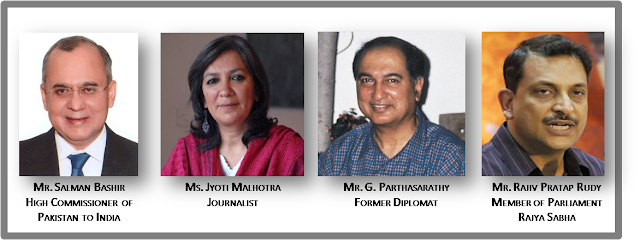Panelists:
Mr. G. Parthasarathy, Former Diplomat
Mr. Salman Bashir, High Commissioner of Pakistan to India
Ms. Jyoti Malhotra, Journalist
Mr. Rajiv Pratap Rudy, Member of Parliament-Rajya Sabha
Mr. G. Parthasarathy, Former Diplomat
Mr. Salman Bashir, High Commissioner of Pakistan to India
Ms. Jyoti Malhotra, Journalist
Mr. Rajiv Pratap Rudy, Member of Parliament-Rajya Sabha
India emerged as one of the prominent players on the global trade scenario in the last decade. Its global trade figures stand at USD795.3 billion by FY12, a CAGR 18 percent improvement from
2008 when this figure was USD 414.8 billion. India's trade with South
Asian Association for Regional Cooperation (SAARC) is worth only USD13
billion even though its global trade has crossed the USD750 billion
mark. Indian companies have invested more than USD100 billion outside
India and more than 90 percent of this investment has been made outside
South Asia. The country has got investment worth around USD10 billion
from SAARC nations. Moreover, with a total population of more than 1.5
billion, South Asia has more people than any other regional blocs in the
world. Even then the SAARC’s contribution to bilateral trade with
India is a mere 2 percent.
The volume and the value of India’s trade with SAARC nations reinforces the need to create a more conducive investment climate, which will go a long way toward strengthening ties among all the participating industry bodies and integrating South Asia as a major trading bloc.
In order to achieve these goals, the Government of India is stressing on liberalising trade under the South Asian Free Trade Area (SAFTA) agreement, which came into force in 2006. India is committed to building a unique South Asian identity for all the countries in this area. Keeping up with its commitment, India has reduced the number of trade items in the sensitive list for SAARC's non-least developed countries (NLDCs), such as Pakistan. This move is likely to further expand trade in the region.
The Cabinet’s approval to reduce 30 percent — or 264 — of such items for NLDCs and a unilateral reduction in its sensitive list for the Least Developed Countries (LDCs) to 25 items while allowing all other imports at zero basic customs duty reiterate the fact that India is leading from the front in harmonizing the SAFTA framework, which is central to developing a vibrant economic community. India’s decisions have so far benefited Pakistan, Afghanistan, Bangladesh, Bhutan, Maldives and Nepal.
While India is committed to the cause, it’s disappointing to learn that other South Asian countries are yet to reciprocate in
a similar manner. Some of the member nations are yet to lower trade
barriers and help Indian companies give more business opportunities. A
case in point is India’s lowering of peak tariffs for imports from Pakistan under SAFTA. By delivering on its promise, India decreased peak rates to 8 percent by January 1, 2012, and to 5 percent by
January 1, 2013. However, Pakistan hasn’t reciprocated the gesture so
far and it is also yet to live up to the commitments it made to SAFTA.
The time has come for South Asia to take note of other bloc economies, which have adopted a ‘regional economic integration’ policy
for an equitable and balanced growth of the region as a whole. For
that to happen, all South Asian counties will have to work together as a
cohesive unit. Otherwise, India will be left with no option but to look for alternatives for regional associations in South East Asia.


No comments:
Post a Comment